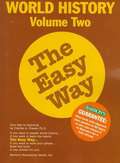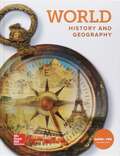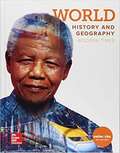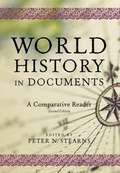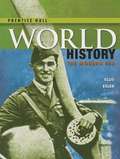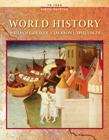- Table View
- List View
World History Shorts 2
by Kristina M. SwannWORLD HISTORY SHORTS are fun, "bite-sized" history lessons for students reading below grade level. These engaging programs were designed for students of all ages who need help learning the basic concepts covered in world history classes. The low reading level and age-appropriate illustrations make the short, high-interest passages and activities appealing to struggling readers and students with learning differences. THE SHORTS - Each 210-page binder includes between 28 and 30 one-page stories, or shorts, that focus on key historical concepts. Featured in 14-point font for easier readability, the shorts can be used as introductory lessons or taught in greater depth with additional resources. They also serve as an overview for topics that teachers.
World History The Easy Way Volume Two: AD 1500 to the Present
by Charles A. FrazeeVolume II opens with major world events between 1500 and 1789, and considers the development of shipbuilding that sent European explorers around the world. Following topics include the Ottoman Empire, Mughal India, Manchu China, Spanish conquests in the Americas, European world colonialism, the French Revolution, Napoleonic Europe, British imperial expansion, the revolutions in the Americas, the United States and Canada as world powers, World War I and II, postwar Europe, the end of European colonialism, the Cold War, modern China, and events affecting Pacific nations.
World History and Cultures in Christian Perspective (2nd Edition)
by George Thompson Jerry CombeeThis book shows the relation between history and the Bible.
World History and Cultures in Christian Perspective (Third Edition)
by George Thompson Jerry CombeeA textbook on World History and Cultures in Christian Perspective. This is the third edition.
World History and Geography Modern Times
by Jackson J. SpielvogelWorld History and Geography, Modern Times.
World History and Geography, Chapter Tests & Lesson Quizzes
by McGraw-Hill EducationNIMAC-sourced textbook
World History and Geography: Early Civilizations Through the Fall of the Western Roman Empire, 6th Grade, Social Studies Student Book
by Carole MarshNIMAC-sourced textbook
World History and Geography: The Industrial Revolution to the Present
by Jackson SpielvogelNIMAC-sourced textbook
World History and You
by Vivian BernsteinAs you read World History and You, you will learn how people started the first cities and why many early civilizations disappeared. You will learn how wars and inventions have changed the world forever.
World History in Documents: A Comparative Reader (2nd edition)
by Peter N. StearnsThe book covers key events that have altered world history since the publication of the first edition, including terrorism, global consumerism, and environmental issues. In addition to including a new preface, focusing on current trends in the field, Stearns has updated forty percent of the textbook, paying particular attention to global processes throughout history.
World History of the Modern Era
by Elisabeth Gaynor Ellis Anthony EslerPrentice Hall World History's Concept Connector Solution provides you with a variety of strategies and tools to help you truly understand the past, demonstrate your knowledge of world history, and succeed on quizzes, projects, and high-stakes tests.
World History the Modern World (California Edition)
by Elisabeth Gaynor Ellis Anthony EslerHistory textbook
World History to 1500 Sixth Edition
by William J. Duiker Jackson J. SpielvogelWORLD HISTORY textbook
World History with Student Activities, Volume A (3rd Edition)
by Carl Abrams Lynn Garland Nathan Lentfer Dennis Peterson Bryan SmithWorld history transports a student through time, revealing a variety of cultures and civilizations and the development and expansion of ideas. In addition, the study of world history reveals many of the consequences of decisions made by men, leading to triumph or tragedy. During this academic journey the student also gains insights on related subjects, including religion, art, science, and other aspects of culture.
World History with Student Activities, Volume B (3rd Edition)
by David A. FisherThe study of world history profits a student in many ways. Such a study broadens the intellectual horizon by exposing the student to a past that goes all the way back to "In the beginning God created the heaven and the earth." World history transports that student through time, revealing to him a variety of cultures and civilizations and the development and expansion of ideas. In addition, the study of world history reveals many of the consequences of decisions made by men, leading to triumph or tragedy. During this academic journey the student also gains insights on related subjects, including religion, art, science, and other aspects of culture.
World History, Culture, & Geography, The Modern World
by Jackson J. SpielvogelNIMAC-sourced textbook
World History, Culture, & Geography: The Modern World, Inquiry Journal
by Jackson J. SpielvogelNIMAC-sourced textbook
World History, Fourth Edition
by Dennis E. BollingerWorld History, 4th edition, recounts the story of mankind from creation to the present. Students examine ancient civilizations through the Greeks to the Roman Empire. Then they survey India, Asia, and Africa on their way to the Middle Ages, the Renaissance, and the Reformation, upon which modern history is founded. They are challenged to discover the forces, issues, people, and movements that have shaped our modern world. God?s providence and Bible integration are given prominence as the students are taught to view the world through a Christian lens.
World History, Interactive: The Modern Era
by Elisabeth Gaynor Ellis Anthony EslerNIMAC-sourced textbook

